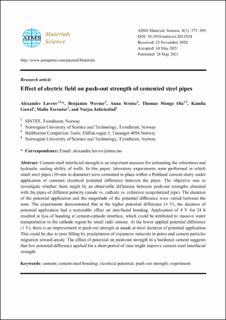| dc.contributor.author | Lavrov, Alexandre | |
| dc.contributor.author | Werner, Benjamin | |
| dc.contributor.author | Stroisz, Anna Magdalena | |
| dc.contributor.author | Øia, Thomas Monge | |
| dc.contributor.author | Gawel, Kamila | |
| dc.contributor.author | Torsæter, Malin | |
| dc.contributor.author | Jafariesfad, Narjes | |
| dc.date.accessioned | 2022-09-05T06:39:14Z | |
| dc.date.available | 2022-09-05T06:39:14Z | |
| dc.date.created | 2021-08-10T15:53:03Z | |
| dc.date.issued | 2021 | |
| dc.identifier.citation | AIMS Materials Science. 2021, 8 (3), 373-389. | en_US |
| dc.identifier.issn | 2372-0484 | |
| dc.identifier.uri | https://hdl.handle.net/11250/3015626 | |
| dc.description.abstract | Cement-steel interfacial strength is an important measure for estimating the robustness and hydraulic sealing ability of wells. In this paper, laboratory experiments were performed in which small steel pipes (10 mm in diameter) were cemented in place within a Portland cement slurry under application of constant electrical potential difference between the pipes. The objective was to investigate whether there might be an observable difference between push-out strengths obtained with the pipes of different polarity (anode vs. cathode vs. reference nonpolarized pipe). The duration of the potential application and the magnitude of the potential difference were varied between the tests. The experiments demonstrated that at the higher potential difference (4 V), the duration of potential application had a noticeable effect on interfacial bonding. Application of 4 V for 24 h resulted in loss of bonding at cement-cathode interface, which could be attributed to massive water transportation to the cathode region by small radii cations. At the lower applied potential difference (1 V), there is an improvement in push-out strength at anode at short duration of potential application. This could be due to pore filling by precipitation of expansive minerals in pores and cement particles migration toward anode. The effect of potential on push-out strength in a hardened cement suggests that low potential difference applied for a short period of time might improve cement-steel interfacial strength. | en_US |
| dc.language.iso | eng | en_US |
| dc.publisher | AIMS Press | en_US |
| dc.rights | Navngivelse 4.0 Internasjonal | * |
| dc.rights.uri | http://creativecommons.org/licenses/by/4.0/deed.no | * |
| dc.subject | experiment | en_US |
| dc.subject | push-out strength | en_US |
| dc.subject | electrical potential | en_US |
| dc.subject | cement-steel bonding | en_US |
| dc.subject | cement | en_US |
| dc.title | Effect of electric field on push-out strength of cemented steel pipes | en_US |
| dc.type | Peer reviewed | en_US |
| dc.type | Journal article | en_US |
| dc.description.version | publishedVersion | en_US |
| dc.rights.holder | © 2021 the Author(s), licensee AIMS Press. This is an open access article distributed under the terms of the Creative Commons Attribution License (http://creativecommons.org/licenses/by/4.0) | en_US |
| dc.source.pagenumber | 373-389 | en_US |
| dc.source.volume | 8 | en_US |
| dc.source.journal | AIMS Materials Science | en_US |
| dc.source.issue | 3 | en_US |
| dc.identifier.doi | 10.3934/matersci.2021024 | |
| dc.identifier.cristin | 1925169 | |
| dc.relation.project | Norges forskningsråd: 285568 | en_US |
| cristin.ispublished | true | |
| cristin.fulltext | original | |
| cristin.qualitycode | 1 | |

